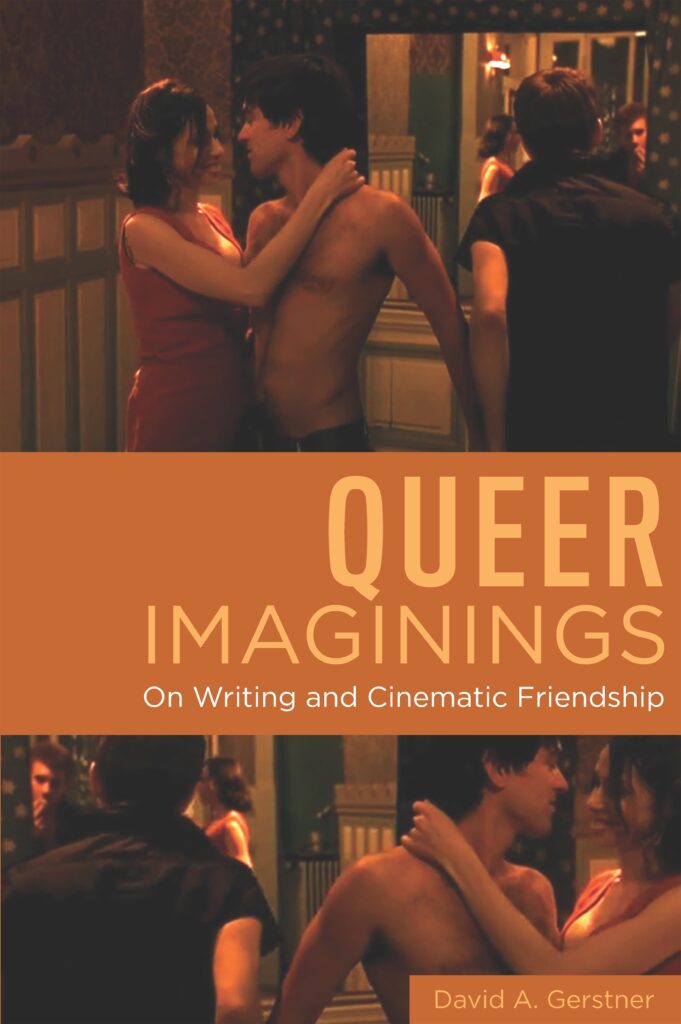
Reviewed by George Cunningham
David Gerstner opens his introduction to Queer Imaginings: On Writing and Friendship with a simple statement of intent, “This book is about writing” (1). Yet, when a monograph covers decades of a writer’s work, spanning topics such as race, friendship, auteur theory, and aesthetics, how does a writer write about writing, without centrally focusing the process of writing itself? Queer Imaginings solves this conundrum by situating itself as a self-reflexive anthology; a work which mingles “critical essays, book and film reviews, interviews, and other jottings” within a state of ecriture (1). Gerstner leans into this term, ecriture, as a means to situate his work as “writing by both film critic and the filmmaker” (1). In doing so, Gerstner successfully links over 30 years of queer film studies within the overarching investigation of the “queer auteur”, defined early on in the introduction as “a singular voice enduringly dependent on the Other” (2). Queer Imaginings focuses its understanding of queer auteurship onto a selection of queer, predominantly 20th century, gay male filmmakers who, while separated by class, race, and aesthetics, each demonstrate their own stylistic tendencies while also being inextricably linked to queer ideological process. Marlon Riggs, Vincent Minnelli, Christopher Honoré, and Peter Greenaway are each discussed within their respective stylistic bubbles, yet Gerstner expertly situates each within his definition of the queer auteur, showing how each of these lauded filmmakers are intrinsically linked to expressions of community, friendship, history, and queerness.
Gerstner divides his book into three thematically linked sections, each diving into different themes and ideas, while effectively connecting each to his overarching thesis of the queer auteur. The first section ,“Politics, Love, and the Queer Auteur”, performs the task to setting up Gerstner’s narrative of queer friendship and auteurship that separates itself from alternative takes on the author-product relationship by proposing that the “queer auteurs find themselves pushing against white-heterocentric crosscurrents” (11). The opening essay within the first section includes an introduction from his 2011 book, Queer Pollen, titled “White Seduction, Black-Male Homosexuality, and the Cinematic”. In this, Gerstner mines the work of prominent Black authors, namely James Baldwin, Richard Bruce Nugent, and Marlon Riggs, to analyze the “seduction” of white artistic form on the Black, queer imaginary. This introduction uses a quote from Baldwin’s If Beale Street Could Talk which sees the character Tish staring into the eyes of a racist white cop – “It was seduction which contained the promise of rape. It was rape which promised debasement and revenge: on both sides” (26). Through the evocation of rape and revenge, Baldwin, Nugent, and Riggs’ work is placed in conversation with the cinematic histories that they each draw from. Gerstner effectively displays the complexities of Black authorship within white production ideals by identifying the meta-narrative through which white iconography and cinematics are used to subvert white-heterocentric thought, which “gives shape to queer Black identity not as a form of the true but as a mobile process that comes to terms with the power of the false” (41). In his introduction, Gerstner lays the foundation of his evaluation of the auteur within contemporary discourses by redefining how the auteur functions in the face of history and community.
While Gerstner uses the first part to set up the ongoing theoretical tension present within his book, section two marks the author’s travels into interdisciplinary studies and his continued preoccupation with authorship in late capitalism. Here, Gerstner’s commitment to the overall thesis of the book remains steadfast, examining this wide range of artistic talent through the tensions of queerness, authorship, and historiography. Unlike the opening section, however, “Archival Penetrations” encompasses a wider range of essays, reviews, and critiques, each investigating an array of topics from Oscar Wilde and dialectical materialism to Peter Greenaway’s Eisenstein in Guanajuato (2015) and the tensions of desire/death within the montage.
Taking a closer look at the essay “In Excess of the Cut: Peter Greenaway’s Eisenstein in Guanajuato”, we can see the precision in which the author teases theoretical depth within his writing. The essay opens with an air of memoir, as Gerstner recounts his obsession with Sergei Eisenstein (the great Soviet montagist), Peter Greenaway, and Derek Jarman. While dwelling on the mixture of aestheticism and montage that all three of these filmmakers innovate, Gerstner reflects on how, as a young film studies student, he found Eisenstein’s use of montage more then just montage-as-cut but rather as “erotically mesmeriz[ing]” (114). The erotics of Eisenstein’s montage is revealed in Gerstner’s close attention to the mise-en-scene within Eisenstein’s notoriously tight montages, as his mix of “chiselled young men” who lead protest against the bourgeois factory owners is cut with him jumping “naked into the sea to avoid the … spies” (114). Eisenstein’s conversation between the “homo-erotic and ultra-aestheticized mise-en-scene” (115) is precisely what draws Gerstner’s attention to, not only Eisenstein’s filmography, but also Greenaway’s exploration of Eisenstein’s time in Mexico in Eisenstein in Guanajuato. Greenaway’s film focuses on the ten days in which Eisenstein “rethought the crucial relationship between cinematic montage and sexual desire” (115). What Greenaway’s film contextualizes about Eisenstein is that his queerness and his montage were intrinsically connected, as Eisenstein’s theories covered up, or perhaps overshadowed, his queer sensibilities. In an era of emerging sound technologies, montage became an unstable term; not just for the cut of the image anymore, montage had to encompass all of the cinematic arts. Greenaway further highlights the aesthetics of Eisenstein’s use of montage, as he foregrounds homoerotic tensions between male bodies, place, and political ideology. In turn, Gerstner illuminates both the limitation and excess of montage, as here montage exists not within the cut itself but within the association brought forth by Greenaway’s images of historical persona and queer sex.
This third and final section is recognizably titled “On Writing and Cinematic Friendship”. In his final pages, Gerstner pierces the theoretical veil that has been set up within the first two parts and effectively brings together what could have been a rag-tag grouping of topics into a visionary whole. Not unlike the first two sections, “On Writing and Cinematic Friendship” encompasses a large array of films, filmmakers, and theoretical concepts, from multi-artistic talents like Christophe Honoré and New Zealander Peter Wells, to a DVD review of Marlon Riggs’ Tongues Untied (1989). Each essay within this section acts to bring together Gerstner’s breath of interests while homing in on his obsession with modern day auteurs and the theoretical placement of the auteur within 21st century sensibilities.
In any other book, what would act as an expansion and clarification of theoretical insights is turned into somewhat of a conclusion, as Gerstner forgoes the traditional formal conclusion and leaves the web of decades’ worth of work open to further exploration rather then closing it off with a final proclamation of his overriding thesis. What acts most accordingly as a conclusion is an “in Memoriam” that Gerstner wrote (with Matthew Solomon) for auteur theory super-star Peter Wollen. Here, Gerstner, with tinges of sadness, celebrates the life and work of Wollen, a man who has had a clear influence over Gerstner’s own research. Gerstner proclaims that Wollen “was not ahead of the curve; he made the curve” (285). Within this obituary, Wollen’s work is never delved into in any depth, though that is not the point here. What Gerstner ends his book on is a celebration of the two main theoretical standpoints that Queer Imaginings is built on, writing and friendship: by mourning someone who was not just a good friend of Gerstner’s, but also someone who celebrated and encouraged creativity within academic writing, championing the accessible within academics and creating a space of individualized voices.
In summary, Gerstner leaves his book with a proclamation on the powers of writing and friendship, not from a theoretical standpoint (the author seems aware that this is well covered by this point), but from a very personal place. It’s one that pushes readers to explore and revel in the language and peoples who we surround ourselves with. In ending his vast and varied anthology in such a way, Gerstner launches his work not to an end point but to a new beginning, exemplifying a very curious and creative drive that all great ecriture auteurs must possess.

